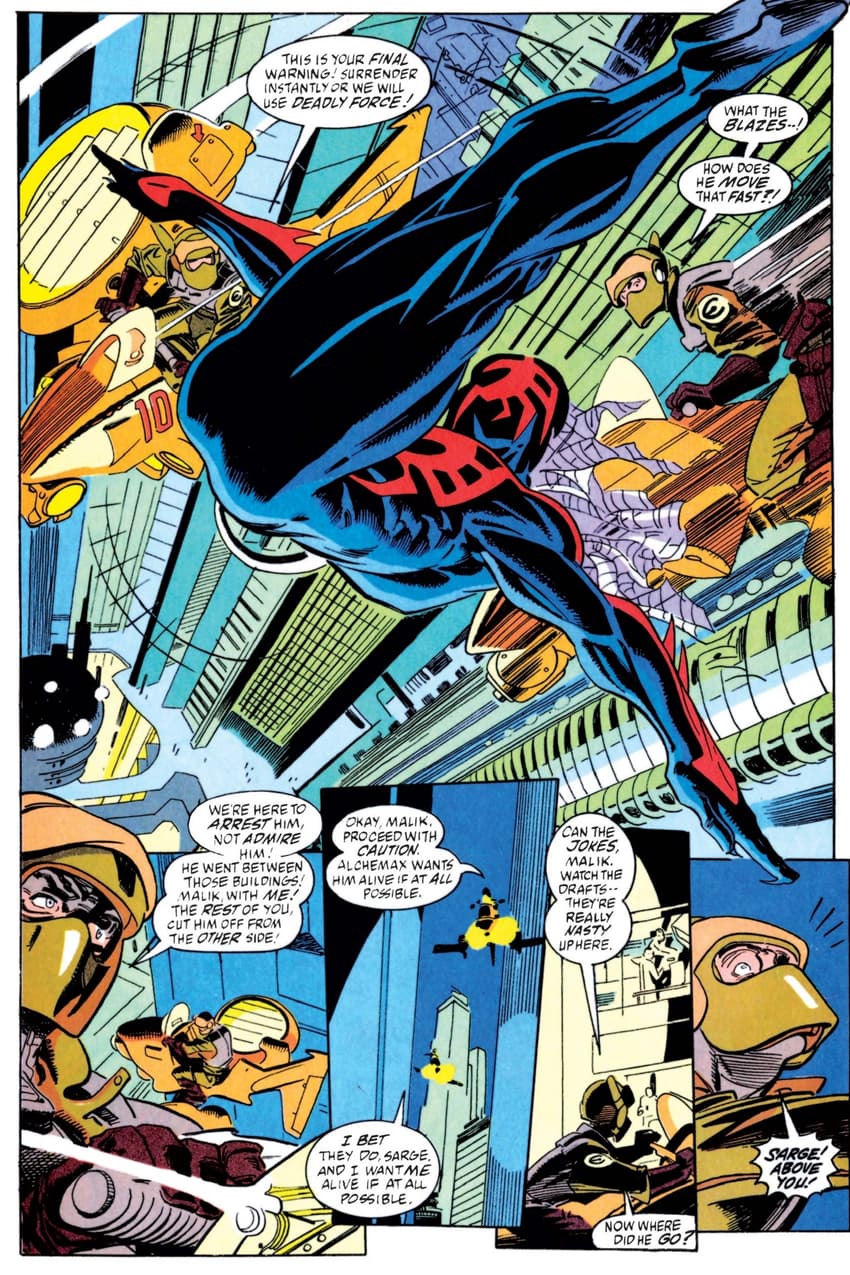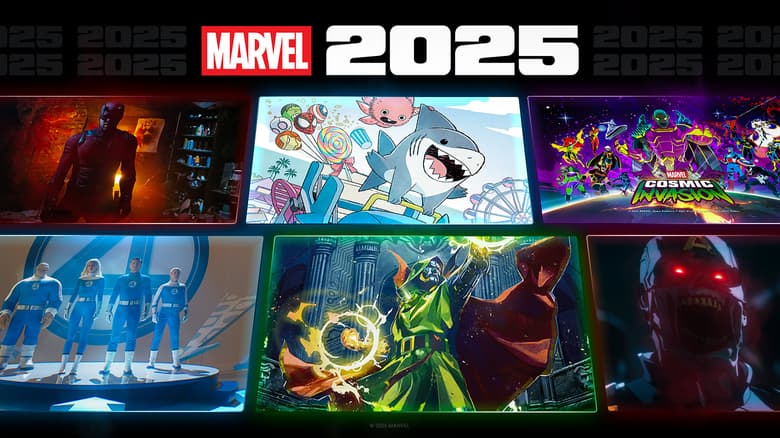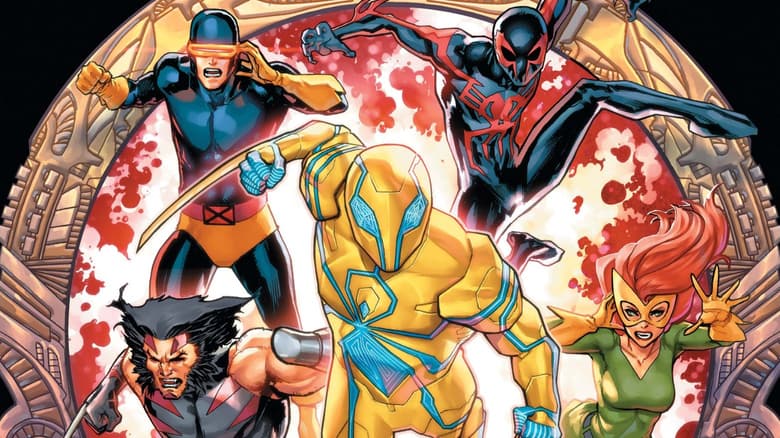Spider-Man 2099: Future Shock
We spoke with writer Steve Orlando about his epic exploration of Miguel O’Hara, AKA Spider-Man 2099, in ‘Spider-Man 2099: Dark Genesis.’
Miguel O’Hara is having a moment. The fan-favorite Spider-Hero of comics and the big screen, Spider-Man 2099 has also recently starred in a pair of series written by Steve Orlando: SPIDER-MAN 2099: EXODUS and SPIDER-MAN 2099: DARK GENESIS. As the “Dark Genesis” series is unfolding now on Marvel Unlimited, we huddled with Orlando and let the current architect of Marvel 2099 speak on his work to date as well as what comes next.
[RELATED: Meet Miguel O’Hara, Spider-Man 2099]
Were you reading comics when the 2099 line debuted? How did you first encounter these characters?
STEVE ORLANDO: I was! In 1992, I was right in the strike zone for the 2099 line—a cool new cyberpunk vision of the future. And it helps that the talent on the launch was impeccable! There’s a reason the 2099 characters have stood the test of time.
What struck you as the strongest creative hallmarks of Marvel 2099?
STEVE ORLANDO: [That] the core concepts have endured because the base creative was very prescient! The world may not look like 2099 now, but a lot of the far-flung day to day realities of the future presented in the launch titles are either already now part of our lives, or they’re on their way. And to be frank—2099 has, from the start, had some of the most incredible designs. Yes, that’s not necessarily something that speaks to story longevity, but Spider-Man 2099 is a timeless look, instantly cool, even if you don’t know Miguel’s story. And that is a cornerstone of expanding appeal. And not just Spider-Man. The X-Men, Ghost Rider, Doom...2099 was a slick, awesome world you just had to visit. You’ve got visuals you can’t turn away from, and a world that’s a gripping future reflection of our present. That was the sauce, and it still is!

What do you think made Miguel O’Hara the most high-profile character to emerge from 2099?
STEVE ORLANDO: It’s not just the look—Miguel was decades ahead of his time. He wasn’t trying to be like Peter Parker, the Spider-Man of a past heroic age. He was defining Spider-Man on his own terms, with his own motivations. He was at the same time absolutely a Spider-Man, but not a variation of Peter’s style. Miguel had humor, but it was more cutting, darker, often cynical. He had an anger in him as to how he’d been treated by the system. And even though he was from the future, he was a former corporate cog being taken advantage of by his employer—he was relatable, fighting back against forces that might’ve been neon and futuristic, but that we could all relate to fighting against our whole lives.
How did the idea for SPIDER-MAN 2099: EXODUS come about?
STEVE ORLANDO: We wanted to go big for the 30th Anniversary [of 2099]! “Exodus” was a chance for us to bring together all the 2099 content from the past 30 years for a huge moment, the death of a Celestial, that upends life as people know it in Nueva York. We wanted to do event-style storytelling with a lasting change—and the creation of Oasis X was absolutely that. But it wasn’t just Oasis X, it was the fact that those at the top of society could now no longer assault everyone else with impunity. Miguel, the working-class hero of the future, effectively decapitated the 1% and changed 2099’s power structure from top to bottom. And of course, we merged all the existing 2099 timelines into Earth-2099, creating one reality with the best of all previous versions, celebrating a new heroic age kicking off in 2099, but not limited to that year.
What were you hoping to accomplish by the end of your “Exodus” run?
STEVE ORLANDO: A societal shift for 2099. Miguel has always been the working-class hero of the future. That’s always Spider-Man. Standing up for “the little guy” in every timeline and reality, even if that plays out in different ways. And Miguel can be vindictive, a trait I share with him. So, in putting him up against Norman Osborn and his untouchable Cabal, we knew Miguel had to make a big move. We knew he had to beat them not just in the moment, but for the future. So that meant cutting the head off of a predatory society’s snake.

When we continue the story in SPIDER-MAN 2099: DARK GENESIS, the destruction of the Black Cards has created a major social disparity. How did real world issues influence your storytelling?
STEVE ORLANDO: With 2099, and with speculative fiction in general, the real world is always the seed for extrapolation. They were calling stuff in 1992 that’s already happened, even if it wasn’t as neon as they thought it would be! So here, with “Dark Genesis,” we got a chance to tip our hats to MAXIMUM CARNAGE, as well as how easily a righteous cause can be poisoned by bad actors. Miguel sparked a revolt against the cruel, murderous elite in “Exodus.” After years of being abused and killed by them, those they hurt want revenge—it’s not enough that their attackers are now penniless. And once Carnage hits the scene, he plays on the anger and rage to turn a just cause toxic. His followers are his first victims.
Where is Miguel’s head at for the start of “Dark Genesis” versus the end of “Exodus”?
STEVE ORLANDO: He’s exhausted. And he’s conflicted—he believes in people, believes in laying freedom and justice at their feet. And he agrees with their anger. But he can also see how some people are turning something righteous into something petty and horrific. Miguel’s worried he maybe gave people too much credit—he wants to save people, always. But how does he save them from themselves? It’s got him doubting his bold actions. But luckily, Miguel’s not alone in the fight—and he’s got allies who know Nueva York still needs its Spiders.
Where did the concept for Carnage come from? Why was this the perfect threat to adapt for 2099?
STEVE ORLANDO: Carnage 2099, like much of 2099, was about honoring the inspiration for the characters but also intensifying and innovating around that. Carnage himself lives for slaughter, but Carnage 2099 literally needs to kill to survive. He’s a murder engine that burns blood like gasoline. And though he’s a creature, this almost makes him a primal, chthonic force. And it’s tragic! In trying to create a medicine that could be programmed to hunt, kill, and consume bloodborne diseases, Alchemax created a weapon of pure destruction. They never accounted for their wonder medicine’s appetite being bottomless.

What is the process of creating new 2099 incarnations of familiar present-day characters?
STEVE ORLANDO: It’s always a conversation! We’re all a team here—from editorial to folks on the visual art side, to coloring and lettering, the whole squad. So, we start with the ideas above—how can we nod to the inspiring character, how can we make a character that’s say, still Blade, but from a whole new lens? That’s what happened with the original line—Miguel is absolutely Spider-Man, but in a new context with a new set of rules. The same goes for X-Men, for the Punisher, and for all of 2099’s icons. It’s always about cutting down to the core of the character, and then building back out around it. Like stripping something down to its skeleton, and then laying the meat back on in a new way. And that’s not just me, the writer—it’s the whole creative team!
How did you dream up Blade 2099 as a zombie?
STEVE ORLANDO: The ethos we talked about above was the key here. How can we have a character that’s definitely Blade, but also different. How can we evolve the concept? Here, we have a man whose origin mirrors Blade’s. He’s half-zombie, born to someone fatally bitten while pregnant. Having lost his mother, Blade 2099 is found and mentored by Blade in the same way Blade was by Whistler [in some presentations]. He struggles with the hunger as Blade struggles with the thirst. But he’s not the same—he breaks away from Blade to pursue medicine, to better understand and decode his hunger. He’s a warrior, he’s a doctor. And yes, thanks to technology that’s just a step past our own, instead of a serum, he prints artificial human meat in a 3D printer to hold back his zombie side.

Halloween Jack was my favorite (relatively) deep cut for this series. Why did you decide he fit your needs?
STEVE ORLANDO: It was always a matter of time until Jack came back—he’s a 2099 icon with a great combination of traits. Jack gives us the energy of a Loki-like trickster—he was even 2099’s Loki at one point—but also a notorious clown prince of crime. And even a bit of Carnage’s crazed bloodlust! He wasn’t a fit for “Exodus,” but once we knew “Dark Genesis” would be an ode to MAXIMUM CARNAGE, we knew the perfect person to rile up the crowd and pull even more people to Carnage’s side...all the while poking the beast and making sure the blood flows thicker and deeper.
What do you hope people walk away from “Dark Genesis” with?
STEVE ORLANDO: Excitement! And, of course, an eye for what’s next. A (non-zombie) hunger for what’s to come. “Dark Genesis” reminds us Spider-Man 2099 is the guy that’s never giving up on us, even if we give up on him. He’s the guy ready to throw himself into the fire to keep us from the flames. And as he says—under the mask, Nueva Yorkers have seen him thousands of times and didn’t know it. He’s a reminder for folks that anyone you see on the street could be a hero.
How was it collaborating on this project with Justin Mason, Jordan Boyd, Antonio Fabela, Cory Petit and cover artist Nick Bradshaw as well as the editorial team?
STEVE ORLANDO: It’s a dream! These folks are all part of the team. “Exodus” and “Dark Genesis” are products of all our work, that undefinable alchemy of collaboration. Justin is a murderer on the page, putting out five issues of blockbuster chaos like it’s a walk in the park. And that’s not even mentioning Nick Bradshaw’s epic series of covers capturing Carnage’s citywide mayhem! Jordan and Antonio’s colors pop and make even more real the neon tomorrow of 2099, and Cory effortlessly laid out and enriched 2099’s lettering by masterfully making it part of the story—with captions and balloon styles that guide the eye and add detailing to the book’s world at the same time! As for Mark Paniccia and Danny Khazem in editorial, they’re the circulatory system holding this all together—but more than that, they’re the guides helping us do the best version of our work.

What’s next for the 2099 universe and Miguel O’Hara?
STEVE ORLANDO: SYMBIOTE SPIDER-MAN 2099 is up next [in 2024]! And it’s going to be a killer!
Read SPIDER-MAN 2099: EXODUS in full then begin reading SPIDER-MAN 2099: DARK GENESIS on digital comics super-service Marvel Unlimited!
The Daily Bugle
Can’t-miss news and updates from across the Marvel Universe!








